Basic Information
Description
The protein encoded by CD3E gene is the CD3-epsilon polypeptide, which together with CD3D, CD3G and CD3Z, and the T-cell receptor alpha/beta and gamma/delta heterodimers, forms the T-cell receptor-CD3 complex. CD3E is critical for normal formation and function of the TCR-CD3 complex and thus is a promising target for immune activity modulation.
Glypican 3 (GPC3) is a member of the family of glypican heparan sulfate proteoglycans (HSPGs). The GPC3 gene may play a role in controlling cell migration, negatively regulating cell growth and inducing apoptosis. GPC3 is frequently upregulated in hepatocellular carcinoma (HCC).
B-hCD3E/hGPC3 mice (112603) was obtained by crossing with B-hCD3E mice (110008) and B-hGPC3 mice (110873). The exons 2-6 of mouse Cd3e gene that encode the extracellular domain were replaced by human CD3E exons 2-7 in B-hCD3E/hGPC3 mice. The human GPC3 CDS was inserted after the exon 3 of mouse Gpc3 gene in B-hCD3E/hGPC3 mice. The insertion disrupts the endogenous murine Gpc3 gene.
Mouse CD3E was detectable on T cells from spleen of wild-type C57BL/6 mice. Human CD3E was exclusively detectable on T cells from spleen of homozygous B-hCD3E/hGPC3 mice but not in wild-type C57BL/6 mice.
GPC3 was detectable in liver and kidney of wild-type C57BL/6 mice and homozygous B-hCD3E/hGPC3 mice due to the cross-reactivity of antibodies.
Humanization of CD3E and GPC3 do not change the overall frequency or distribution of immune cell types in spleen, blood and thymus.
Humanization of CD3E and GPC3 do not change the blood cell composition and morphology, ALT and AST levels or health of liver.
-
Targeting strategy

-
Gene targeting strategy for B-hCD3E/hGPC3 mice.
The exons 2-6 of mouse Cd3e gene that encode the extracellular domain were replaced by human CD3E exons 2-7 in B-hCD3E/hGPC3 mice. The human GPC3 CDS was inserted after the exon 3 of mouse Gpc3 gene in B-hCD3E/hGPC3 mice. The insertion disrupts the endogenous murine Gpc3 gene.
-
mRNA expression analysis

-
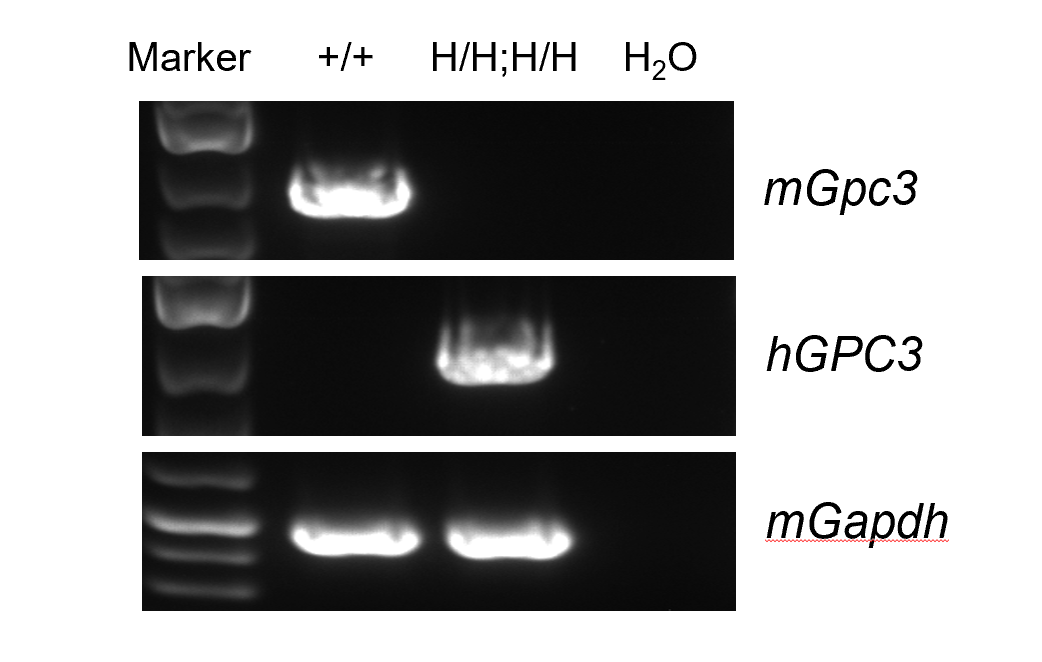
Species specific analysis of GPC3 gene expression in wild-type C57BL/6 mice and homozygous humanized B-hCD3E/hGPC3 mice by RT-PCR.
Kidney was collected from wild-type C57BL/6 mice (+/+) and homozygous B-hCD3E/hGPC3 mice (H/H; H/H). Mouse Gpc3 mRNA was detectable only in wild-type C57BL/6 mice. Human GPC3 mRNA was detectable only in homozygous B-hCD3E/hGPC3 mice, but not in wild-type C57BL/6 mice.
-
Protein expression analysis in liver and kidney

-
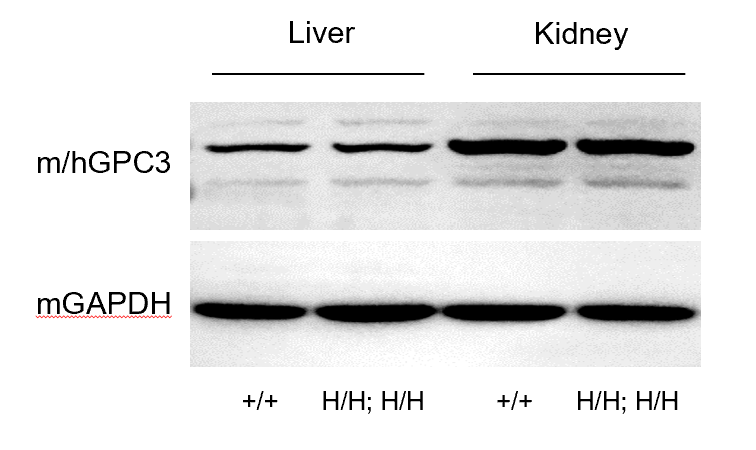
Strain specific GPC3 expression analysis in homozygous B-hCD3E/hGPC3 mice by western blot.
Liver and kidney were collected from wild type (WT) mice (+/+) and homozygous B-hCD3E/hGPC3 mice (H/H; H/H), and analyzed by western blot with anti-GPC3 antibody. GPC3 was detectable in WT mice (+/+) and homozygous B-hCD3E/hGPC3 mice (H/H; H/H) due to the cross-reactivity of antibodies.
-
Protein expression analysis in spleen

-
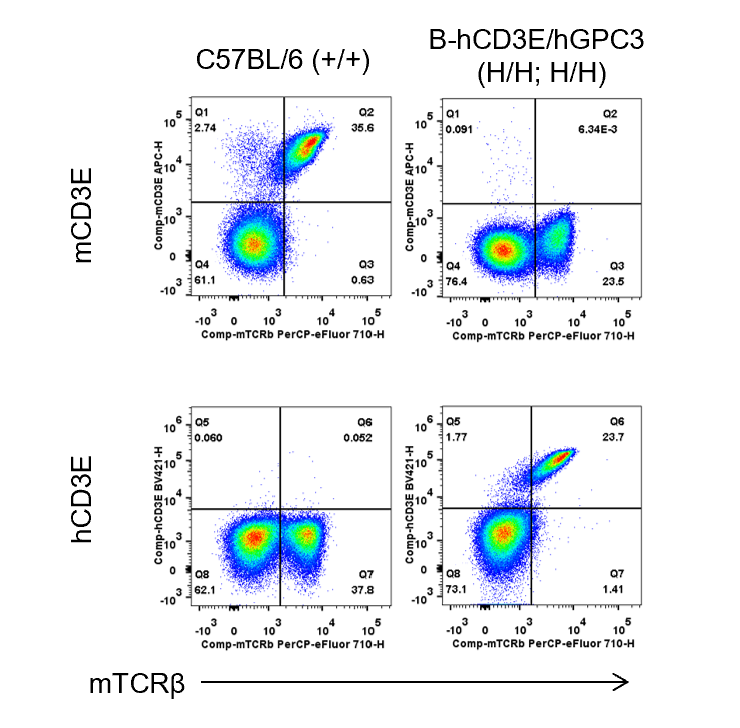
Strain specific CD3E expression analysis in wild-type C57BL/6 mice and homozygous humanized B-hCD3E/hGPC3 mice by flow cytometry.
Splenocytes were collected from wild-type C57BL/6 mice (+/+) and homozygous B-hCD3E/hGPC3 mice (H/H; H/H), and analyzed by flow cytometry. Mouse CD3E was only detectable in wild-type C57BL/6 mice. Human CD3E was exclusively detectable in homozygous B-hCD3E/hGPC3 mice, but not in wild-type C57BL/6 mice.
-
Frequency of leukocyte subpopulations in spleen

-
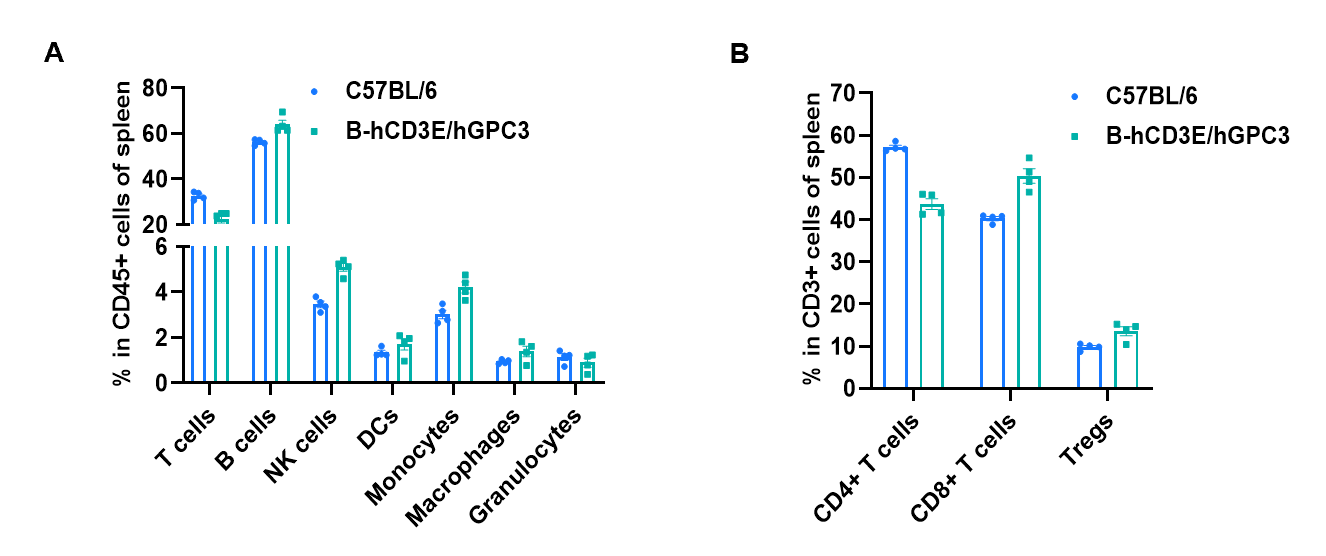
Frequency of leukocyte subpopulations in spleen by flow cytometry.
Splenocytes were isolated from wild-type C57BL/6 mice and homozygous B-hCD3E/hGPC3 mice (n=4, 8-week-old). A. Flow cytometry analysis of the splenocytes was performed to assess the frequency of leukocyte subpopulations. B. Frequency of T cell subpopulations. Percentages of T cells, B cells, NK cells, dendritic cells, monocytes, macrophages, granulocytes, CD4+ T cells, CD8+ T cells and Tregs in B-hCD3E/hGPC3 mice were similar to those in C57BL/6 mice, demonstrating that humanization of CD3E and GPC3 do not change the frequency or distribution of these cell types in spleen. The frequency of leukocyte subpopulations in thymus and blood of B-hCD3E/hGPC3 mice were also comparable to wild-type C57BL/6 mice (Data not shown). Values are expressed as mean ± SEM.
-
Tumor growth curve & Body weight changes

-
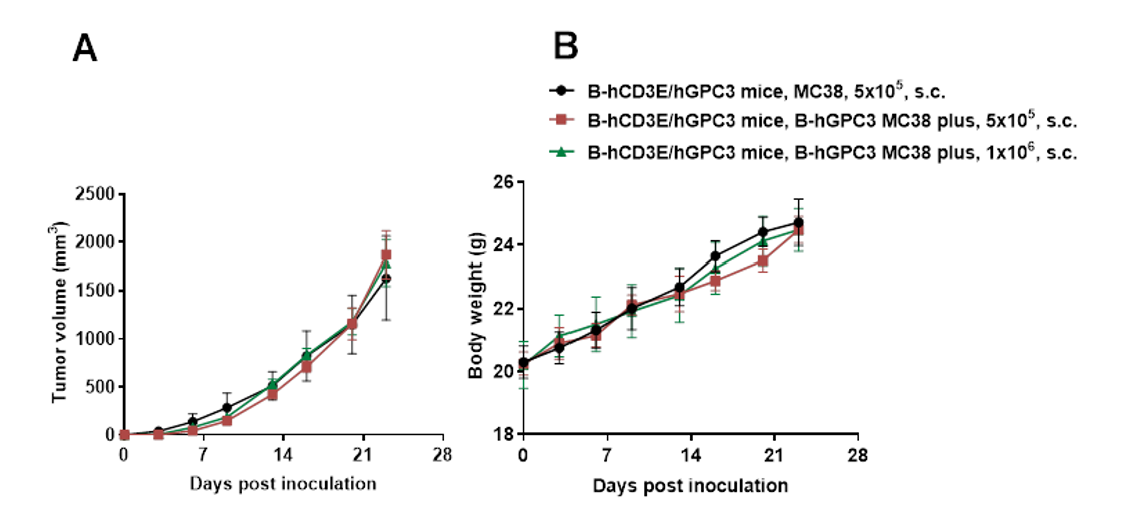
Subcutaneous homograft tumor growth of B-hGPC3 MC38 plus cells.
B-hGPC3 MC38 plus cells (5×105, 1×106) and wild-type MC38 cells (5×105) were subcutaneously implanted into B-hCD3E/hGPC3 mice (female, 7-week-old, n=6). Tumor volume and body weight were measured twice a week. (A) Average tumor volume ± SEM. (B) Body weight (Mean± SEM). Volume was expressed in mm3 using the formula: V=0.5 X long diameter X short diameter2. As shown in panel A, B-hGPC3 MC38 plus cells were able to form tumors in vivo and can be used for efficacy studies.
-
Protein expression analysis of tumor cells

-
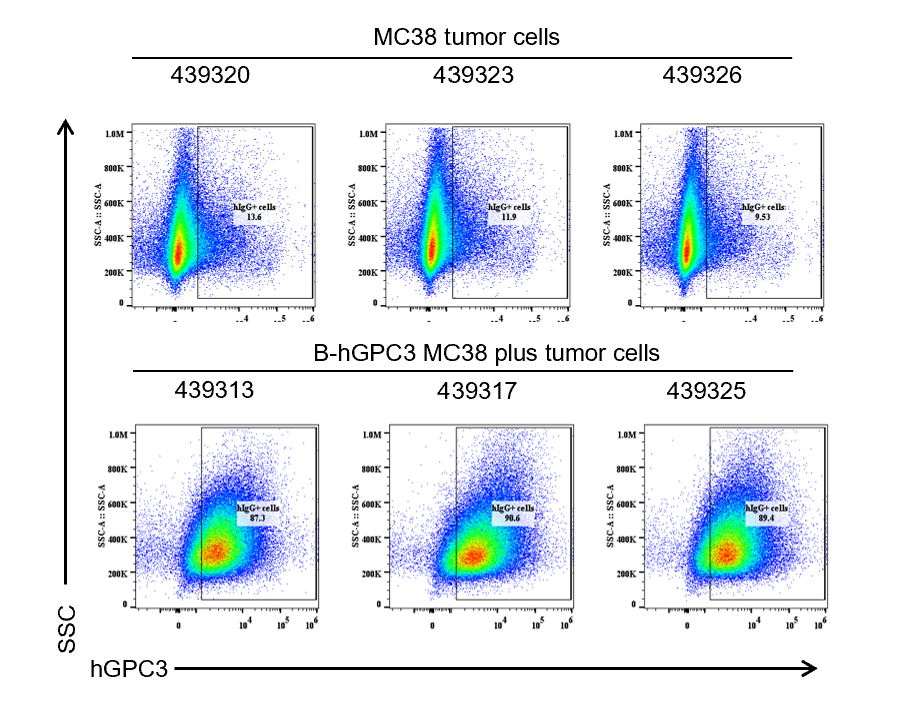
B-hGPC3 MC38 plus cells were subcutaneously transplanted into B-hCD3E/hGPC3 mice (n=6). At the end of the experiment, tumor cells were harvested and assessed for human GPC3 expression by flow cytometry. As shown, human GPC3 was highly expressed on the surface of tumor cells. Therefore, B-hGPC3 MC38 plus cells can be used for in vivo efficacy studies of GPC3 therapeutics.


